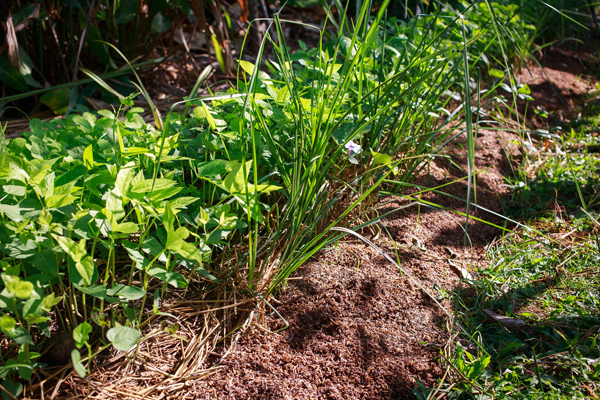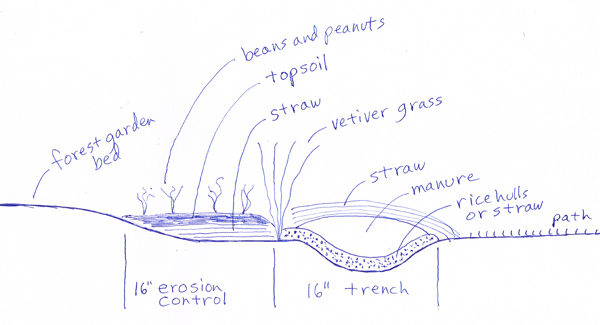
I’m experimenting with a passive compost trench system along the sides of our forest garden beds. The bean borders/compost trenches are primarily for erosion control, building soil, boosting the worm population and suppressing weeds. Secondary benefits include beans for seed and food, attracting pollinators, and benefiting nearby plants with extra nitrogen and water. The bean/vetiver/compost borders also look really good. In a few years the vetiver will grow into 12” clumps and form a continuous hedge, which will provide a continual source of nutrient rich green manure.

In our garden there are now 510 lineal feet of earthworm compost trenches (about 1- 2/3 football field lengths!) that contain about 5 pickup truckloads of manure, rice hulls and straw. How much compost will that produce over the next four months? I hope to get one-half to one truckload of high quality compost mixed with worm castings. We’ll see. When you look at the cost of worm castings in stores all I can say is wow! It’s really expensive. In comparison, this compost system is really cheap. And, it puts the compost where I need it – right next to the garden beds. I’ll shovel the finished compost directly onto the beds right before the rainy season in April.
After about 6 weeks into the experiment this system is working great. One small suggestion: I used rice hulls under and on top of the manure because we didn’t have enough straw at that time. I’ll use straw on top next time, because hulls dry out faster than straw, and a few weeds and some pesty Bermuda grass have grown up through the hulls. No big deal though. This system has reduced weeding around the edges of the beds (the most troublesome area in the garden) by 99%.
More details: The straw, vetiver and beans slow runoff, reduce evaporation and preserve precious topsoil in the garden beds. Beans are wonderful pioneer plants that grow well in less than ideal soil like ours. Because it’s nearly impossible to buy good topsoil or compost here, most of our garden ‘soil’ is actually decomposing layers of sheet mulch – rice hulls, straw, sand, crappy clay soil, sugar cane compost and leaves. Some plants, especially during germination, do not like this mix. We used a mix of red beans, black beans, mung beans, black eyed peas, and some kidney beans to speed the breakdown of the sheet mulch. The kidney beans fared the worst since they got the same amount of overnight soaking as the other beans, and obviously that wasn’t enough time for them. The other beans germinated with a near 100% success rate. Since the photo was taken, we’ve planted the same beans (minus kidney beans) throughout all of the beds to improve the soil. The beans will be chopped and dropped right before the rainy season, covered with compost and replanted with a wider variety of plants. The only drawback to this system is the extra time and effort to water the compost trenches. I water them every 2-3 days depending on how hot it is.

Do you find Vertiver grass for sale locally? I saw some on ebay but it comes from Puerta Rico.
We live in the tropics so yes, it’s easy to get. We can buy rolls of sod or get free starts from the ag center.
We’re making two big batches of EM for the garden and will probably add some soon to the compost trenches with a watering can. The compost would probably break down fine without EM, but since we’ll have lots of EM I figure we might as well try it.